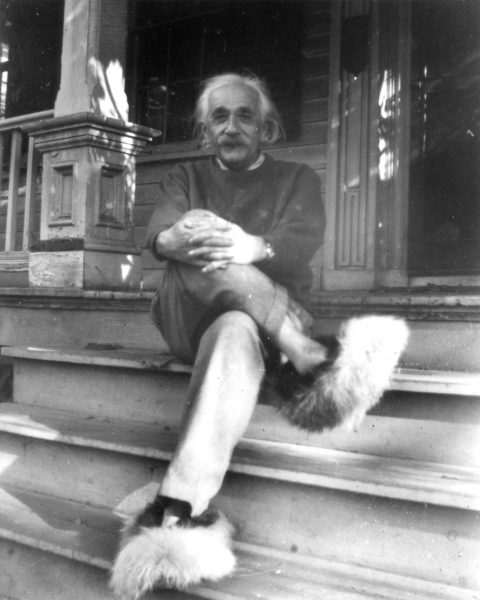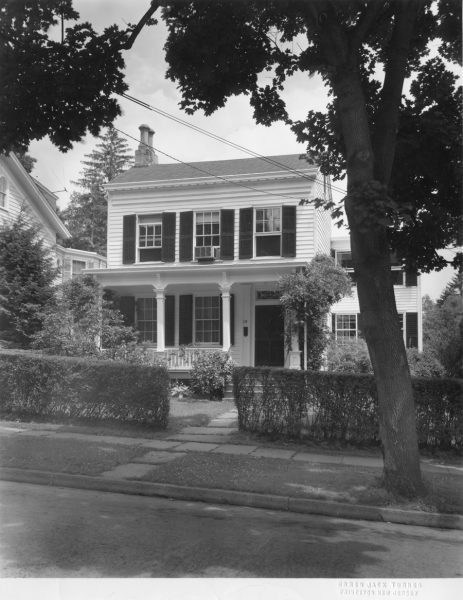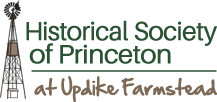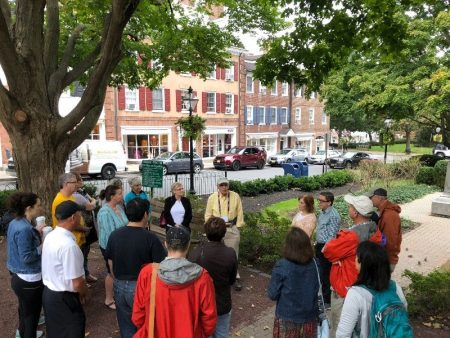
Collection of the Historical Society of Princeton
Albert Einstein (1879 – 1955) first gained worldwide prominence in 1919, when British astronomers verified predictions of Einstein’s general theory of relativity through measurements taken during a total eclipse. Einstein’s theories expanded upon, and in some cases refuted, universal laws formulated by Newton in the late seventeenth century.
Einstein captured the world’s imagination with his blend of brilliant scientific theories and humanitarian concern. The public is still intrigued by Einstein. Visitors come to Princeton from throughout the world to see where Einstein spent the last twenty years of his life.
Einstein Furniture Collection
In 2003, the Historical Society was the proud recipient of a gift of 65 pieces of Albert Einstein’s furniture from his home on Mercer Street, donated by the Institute for Advanced Study. An eclectic collection, the gift includes tables, chairs, chests, cabinets, a bed and other items from the 18th through 20th centuries.
The furniture is representative of several styles and eras. One of the earliest pieces is a Queen Anne table made in Austria between 1730 and 1770. An upholstered tub armchair from the early 20th century appears frequently in photos of Einstein at home. According to James R. Blackwood’s “Einstein in the Rear-view Mirror,” which appeared in Volume 14 of Princeton History, it was local jeweler Isadore Braveman who kept the Einstein’s 19th century Biedermeier-style clock in working order. Blackwood also described the efforts of the underground to send the furniture from Germany to the United States under a fictitious name, which led to difficulties with suspicious customs officials when the Einsteins went to New York to claim their things.
The Historical Society currently displays several outstanding pieces from the Einsten Funiture Collection in the Einstein Salon and Innovators Gallery at the Updike Farmstead, detailing how the furniture arrived in the United States and describing Einstein’s life in Princeton. In the spring and summer of 2005, his desk used in his Berlin study was on loan from the Historical Society to the Max Planck Institute in Berlin for their exhibition Albert Einstein: Engineer of the Universe. In fall 2005, an ensemble of a table, chair and lamp was displayed at the Luther W. Brady Art Gallery at George Washington University in Washington, D.C.
A grant from the New Jersey Historical Commission, Department of State, allowed the Society to catalog the collection and hire a professional conservator to undertake a preliminary survey to assess the conservation needs of each piece. The conservator’s report indicates that over $60,000 must be raised to undo the toll taken by time and use on the furnishings.
Gillett Griffin Collection
In April of 2016, Gillett G. Griffin made a significant gift to the Historical Society of Princeton of over 50 pieces of material related to Albert Einstein, previously in his personal collection.
Griffin was formerly the Curator of Pre-Columbian Art at the Princeton University Art Museum. He had been a personal friend of Einstein’s from 1953 until Einstein’s death in 1955, frequenting Einstein’s home on 112 Mercer Street, where he also became acquainted with the physicist’s stepdaughter Margot Einstein and friend and confidante, Johanna (Hanna) Fantova.
The collection gifted to the Historical Society includes several personal belongings and accoutrements of Einstein’s, including a drawing of Gandhi that used to hang in Einstein’s study and three small handheld puzzle games that Einstein reportedly used to thrust into the hands of acquaintances to solve upon first meeting them. The collection also includes Einstein’s compass – Einstein explained that his interest in physics arose from compasses he played with as a child – and Einstein’s pipe. The only other intact pipe of Einstein’s that is on public display is in the Smithsonian Institution, and it is the most heavily requested object for research and loans in the Institution’s Modern Physics Collection, according to the Collection’s Curator. Gillett received the puzzles and pipe as a gift directly from Margot.
The collection also contains the original snapshot of Einstein sitting on his Mercer Street porch wearing large fuzzy slippers (seen above), as well as the only known self-portrait of Einstein. The drawing, scrawled on a sheet of equations, features Hanna Fantova on a beach, holding an umbrella and smoking a cigarette, with Einstein’s face beside her. Above his head is the exclamation, “Ich hab’s!!,” which translates to, “I’ve got it!” Fantova gave the sketch to Griffin as a gift in 1955, the year of Einstein’s death, because “she thought he would like the design,” according to Griffin.
The photographs, manuscript material, sculptures, books, newspaper clippings, personal possessions, and ephemera that comprise the collection are featured in the Historical Society’s permanent Einstein Salon and Innovators Gallery and can be made available for public research by appointment.
Einstein in Princeton
Scientist, Humanitarian, Cultural Icon
March 5, 1995 – September 15, 1995
Einstein: Scientist
Scientific Work
“REVOLUTION IN SCIENCE
New Theory of the Universe
Newtonian Ideas Overthrown”
– The London Times, November 7, 1919
Einstein’s initial prominence stemmed from his spectacular, yet controversial, advances in theoretical physics, in particular his Special Theory of Relativity (1905) and his General Theory of Relativity (1916), in which he demonstrated the relationship between mass, energy, and gravitation. He was awarded the 1921 Nobel Prize for his work in theoretical physics and, in particular, for his discovery of the law of the photoelectric effect. Einstein’s early work became popularized through the equation E=mc2.
Einstein’s contributions to physics also included advances in statistical mechanics and quantum theory, especially the quantum theory of radiation. During his years in Princeton, Einstein worked on a unified field theory, which sought to discover the relationship between two fundamental interactions of nature – gravitation and electromagnetism. Despite criticism from contemporary physicists and years of unsuccessful research, Einstein never relinquished his search for a unified field theory.
Although Einstein was best known for his theories and writings, he also applied science to daily life through his patents for a noiseless refrigerator, a light intensity self-adjusting camera, and a hearing aid.
Institute for Advanced Study
“. . .a haven where scholars and scientists may regard the world and its phenomena as their laboratory without being carried off in the maelstrom of the immediate.”
– Abraham Flexner, 1931
The Institute for Advanced Study was founded in 1930 by noted educator Abraham Flexner, with funding from department store magnate Louis Bamberger and his sister Mrs. Felix Fuld. Advised to begin this experiment with one field of study, Flexner chose mathematics because it was a fundamental subject which required the smallest investment in buildings or books; there was also greater agreement on the identity of the most eminent mathematicians than on leading scholars in other disciplines.
Flexner first recruited noted mathematicians from Princeton University to join the Institute, such as Oswald Veblen, a Princeton University mathematician and the Institute’s first faculty member. Einstein, recruited directly from Europe, accepted a faculty position in August, 1932. During the 1930s, Flexner broadened the scope of the Institute by including established scholars in economics, politics, and humanistic studies.
Throughout his tenure at the Institute, Einstein worked closely with numerous assistants on his unified field theory. Although Einstein officially retired from the Institute in 1945, he continued his research there until his death in 1955.
Nuclear Energy
“I do not consider myself the father of the release of atomic energy.”
– Albert Einstein, Atomic War or Peace, 1945
In the late 1930s, rapid advances in physics led to the discovery of the fission process, making possible a controlled chain reaction; this meant that the release of atomic power could be sustained at a controllable rate. Many physicists believed that this energy could be harnessed in a powerful nuclear weapon. As political conditions in Europe continued to deteriorate, many scientists became concerned that the German government might have access to the knowledge and materials needed to construct such a weapon. Under the leadership of Hungarian physicist Leo Szilard, scientists, including Einstein, sought to warn the United States government of the need “for watchfulness and, if necessary, quick action on the part of the Administration.”
Einstein collaborated with fellow physicists Leo Szilard, Eugene Wigner, and Edward Teller on a letter in August, 1939, informing President Roosevelt of recent discoveries that indicated it might be possible to build “extremely powerful bombs of a new type.” Motivated by a host of factors, including Einstein’s letter, President Roosevelt initiated programs that led to the Manhattan Project and the eventual development of the atomic bomb.
Einstein’s role in the development and use of nuclear weapons has attained mythic proportions. As Einstein stated after World War II, “My participation in the production of the atomic bomb consisted of one single act: I signed a letter to President Roosevelt . . . in which I emphasized the necessity of conducting large-scale experimentation with regard to the feasibility of producing an atom bomb. . . I saw no alternative but to act as I did, although I have always been a convinced pacifist.”
Einstein opposed the use of the atomic bomb; he urged the United States to demonstrate the weapon to foreign governments rather than use it on an actual target. He was at the forefront of the campaign waged by atomic scientists beginning in the mid-1940s to educate the public and the leaders of the world about the implications of nuclear energy and the absolute necessity of not developing nuclear weapons. As late as the spring of 1955, Einstein worked with Bertrand Russell to launch a project to start a worldwide movement among scientists to reverse the Cold War trend toward nuclear war.
Einstein: Humanitarian
112 Mercer Street
 “But I also found Princeton fine. A pipe as yet unsmoked. Young and fresh.
“But I also found Princeton fine. A pipe as yet unsmoked. Young and fresh.
Much is to be expected from America’s youth.”
-Einstein to a reporter in 1921
In 1932 Albert Einstein accepted a position at the newly-created Institute for Advanced Study in Princeton. Coming to Princeton in October 1933, he and his wife Elsa, along with his personal secretary Helen Dukas, spent ten days at the Peacock Inn, while Elsa looked for a suitable house and Einstein dodged reporters.
The Einsteins’ first two years in Princeton were spent in a two-family house at 2 Library Place. By 1935 Einstein had decided to remain in Princeton and began the formal process of obtaining permanent residency in the United States. The family moved to the white, two-story house at 112 Mercer Street, which would become their permanent home.
After Einstein’s death in 1955 (Elsa had died in 1936), his daughter Margot and Helen Dukas remained in the house until their deaths in 1986 and 1982, respectively. At Einstein’s request the house has never been turned into a museum or public shrine; today it is owned by the Institute for Advanced Study and is used as a private residence.
Family
“. . . these two old people sitting together with their bushy hair, in complete
agreement, understanding and love.”
-Lily Kahler, a close family friend, describing Einstein and his sister Maja
After Elsa Einstein’s death, Helen Dukas took charge of the household, which consisted of Einstein, his daughter Margot, and his sister Maja. Einstein was devoted to his sister, who lived with him from 1939 until her death in 1951, reading to her nightly after she was bedridden from a stroke.
Einstein had two sons, Hans Albert and Eduard, from his first marriage to Mileva Maric, which ended in divorce. In 1919 he married his cousin, Elsa Einstein Löwenthal, and adopted her two daughters, Ilse and Margot. (Ilse died of an illness in 1934.) Margot, an artist and sculptor, shared a deep love of nature with her father.
Devoting the majority of his time to scientific work, Einstein also found enjoyment in sailing, often taking advantage of Princeton’s Lake Carnegie, and music, especially the work of Mozart. Einstein was a well-known figure in Princeton, due in no small part to his shock of white hair, his refusal to wear socks, and his total absorption in scientific problems. Many Princeton residents have fond memories of spotting the famous physicist, lost in thought, walking to and from his office at the Institute for Advanced Study.
Celebrations and Commemorations
“. . . especially when he has, through no will of his own, become a kind of legend in his own lifetime. All manner of fable is being attached to his personality, and there is no end to the number of ingeniously devised tales.”
-Einstein describing himself in a 1954 letter to his lifelong friend Elizabeth, the Queen Mother of Belgium
Einstein’s scientific achievements, coupled with his unpretentious attitude and concern for humanity, made him a beloved, world-renowned figure. Wherever he traveled he was mobbed by people hoping to catch a glimpse of or even touch the genius who had changed their perception of the universe. Einstein himself never understood the public’s fascination with his every word and deed, saying once: “Why is it that nobody understands me and everybody likes me?”
Every year on March 14, Einstein would receive cards, letters, and telegrams with birthday wishes from throughout the world. Even on the centennial of his birth, in 1979, the world celebrated with newspaper and magazine articles, symposiums, publications, and commemorative stamps.
Einstein died on April 18, 1955 in Princeton Hospital; he was cremated and his ashes scattered in an undisclosed location. The worldwide fascination with this kind and gentle genius has not dissipated to this day.
Jewish Saint
“. . . my relationship to the Jewish people has become my strongest human bond, ever since I became fully aware of our precarious situation among the nations of the world.”
-Einstein in a letter to Israeli Prime Minister David Ben-Gurion, November 18, 1952
In the early 1930s Einstein recognized the threat that Hitler posed to Jews living in Germany and to himself in particular as a world-famous Jew. In 1932 Einstein left his country of birth never to return. Throughout the thirties Einstein was deluged with pleas for help from relatives and strangers desperate to flee fascism in Europe. Working against harsh immigration quotas imposed against Jews, Einstein wrote affidavits and enlisted the help of friends in assisting as many refugees as possible. By the end of the 1930s, Einstein had written so many affidavits that his signature on a document no longer carried any weight.
At the same time, Einstein was busy raising funds for organizations such as the United Jewish Appeal, and working toward securing a Jewish homeland in Palestine, which was realized in 1948 by the creation of the State of Israel. When Chaim Weizmann, the first President of Israel and an old friend of Einstein’s, died in 1952 Einstein was offered the Presidency. He regretfully declined, writing: “I am deeply moved by the offer from our State of Israel, and at once saddened and ashamed that I cannot accept it.”
Enfant Terrible
“. . . I have become a kind of enfant terrible in my new homeland, due to my inability to keep silent and to swallow everything that happens there.”
-Einstein in a 1954 letter to his lifelong friend Elizabeth, the Queen Mother of Belgium
Einstein was a lifelong pacifist dedicated to the establishment of a World Government, which he felt would allow nations to work together and abolish the need for war. He could not keep silent about the ills he saw in society; during the anti-communist “witch hunts” of the 1950s Einstein spoke out against the persecution of those who were accused of being “unAmerican,” urging them to commit civil disobedience. He saw a parallel between the American political climate of the postwar period and the fascism of Europe in the thirties.
In answer to a request for advice from William Frauenglass, a Brooklyn high school teacher under investigation by the Senate Internal Security subcommittee, Einstein wrote a letter which was published in The New York Times on June 12, 1953. It read, in part: “Every intellectual who is called before one of the committees ought to refuse to testify, i.e., he must be prepared for jail and economic ruin, in short, for the sacrifice of his personal welfare in the interest of the cultural welfare of his country.”
Einstein: Cultural Icon
Einstein in Popular Culture
“…the public image of Albert Einstein has come to represent intelligence in general, and the scientific mind in particular.”
Alan J. Friedman and Carol C. Donley, Einstein as Myth and Muse
A well-known image in marketing and advertising, Albert Einstein graces magazine ads, T-shirts, mugs, cartoons, calendars, and post cards, and is featured in popular films. The wild-haired, sockless, disheveled, eccentric genius with a heart–our popular culture hero, Einstein–is the currently accepted symbol of intelligence.
Einstein’s image in the mass media evolved during and after his lifetime. Overwhelmingly positive views of Einstein as an intellectual hero prior to the Second World War gave way to tragic portrayals linking him to the development of the atom bomb in the years following the war. Though E=mc2 had no crucial role in the unleashing of atomic energy, Einstein was portrayed in popular culture as the sorrowful father of the atomic age, whose genius was used to tragic ends.
As this mythical connection between Einstein and the atomic bomb was gradually refuted, his name and face once again became the symbol of genius. His status as an icon evolved from intellectual hero to intellectual victim and back again. Today, Einstein is again a popular culture hero.

